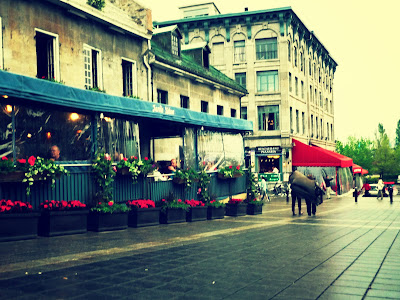HDR Tutorial: Living Room in Casa Loma, Toronto
Here is another tutorial on making HDR images. Today's subject will be the living room in Casa Loma, Toronto. We will achieve this image
I will first describe the concept of HDR imaging and then go on to the process of producing the above image from the actual photographs. If you understand the concept, you may skip to the next section.
HDR Imaging
Consider the photograph I displayed above
Each image has a limited dynamic range of lighting it can capture. Hence, a single image fails to capture all the details of this scene. However, these 3 images together provide us much more information of the scene than a single image can capture. Using these three images, we can create an image much closer to what the eye sees, like the following image
Process
2. Now begins the processing. For producing different projections of an HDR image based on these 3 images, we will use Luminance HDR. Here, I have produced three different images:
4. Some final touches in DarkTable (Refer to Tutorial) and we are done.
 |
| Casa Loma, Toronto |
from this image
HDR Imaging
Consider the photograph I displayed above
This scene has a lot of elements making up for a good composition. However, the image fails to do justice to the scene. So we can try to reduce the shutter speed a little to get the following image
While this image provides a lot of detail on the room, it loses all the details on the candles and curtains, leaving the regions over-exposed. We can capture the details of the curtain and the candle by reducing the exposure (increasing the shutter speed), to get a third image.
Each image has a limited dynamic range of lighting it can capture. Hence, a single image fails to capture all the details of this scene. However, these 3 images together provide us much more information of the scene than a single image can capture. Using these three images, we can create an image much closer to what the eye sees, like the following image
Such an image is produced using special low dynamic range (LDR) projections of high dynamic range (HDR) images which are a combination of multiple "true" LDR photographs and are often called HDR images.
Software Used
Luminance HDR (formerly qtpfsgui), GIMP and DarkTableProcess
1. Capture a set of 3 or more images. Many cameras come with an auto-bracketing feature. If your camera has a +-2 EV auto-bracket, use it. If not, just adjust the exposure compensation to +2, 0, -2 and capture a photograph at each. For this scene, we have the following photographs.
 |
 |
 |
| +2 EV | 0 EV | -2 EV |
 |
| Mantiuk '08 |
 |
| Fattal |
 |
| Ashikhmin |
You can see read more on how to produce these in a previous blog post.
Neither of these images is exactly what we want out of the result, but each of them provides an important attribute to the image:
a. Mantiuk '08 provides the right amount of lighting at the window and the candles.
b. Fattal provides detail across the image along with good color saturation. It can provide a lot of detail, but at the expense of grainy features. Hence, the noise reduction offers a trade-off between detail and noise.
c. Ashikhmin (with Eqn 2) gives good lighting across the image, making it a desirable base for layering in GIMP.
3. Layer the images in GIMP: We layer the three images in GIMP. Fattal layer uses the multiply layer over Mantiuk '08 and Ashikhmin layers which are used in normal mode. The multiply operator tends to increase the contrast of the image, which is desirable in this scene. The Ashikhmin layer provides a good base with low noise for the image unlike the high noise Fattal layer.
4. Some final touches in DarkTable (Refer to Tutorial) and we are done.
Note the detail in the curtains which are visible only in the low exposure (-2 EV) image and the details of most of the room, found in the high exposure (+2 EV) image.
If you found this tutorial helpful, leave a comment below and share it with others on Google+ and/or Facebook.








Comments
Post a Comment